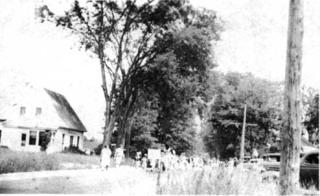Getting Populated

Durham’s population grew slowly. Its early people came from families of Essex County and Cape Cod, Massachusetts, or from southern New Hampshire. Maine’s climate was less hospitable to cash crops such as wheat, and with the opening of the Erie Canal in 1825, families headed west. Towns like Durham sprouted, but grew very little. For most of the 19th century, Maine’s principal export was its people, who took their talents to the plains, forests and thriving towns beyond the Appalachians. By 1900 Durham’s population had grown only to 1,230.
Soon after, the “Sanfordites" (followers of Frank Sanford) located their headquarters at Shiloh Temple in Durham and brought many followers of their Church of the Holy Ghost and Us, an evangelical sect, to town. Running its own schools and industries, its burgeoning settlement brought many newcomers and the population grew to 1,625 by 1910.
The cult’s leader was discredited, and though the church remains active to this day, by 1920 Durham shrank to 1,144 people, and then to 806 in 1930. The Great Depression brought ruin to many in the 1930s, so that Durham had only 784 residents in 1940. Many were still involved in agriculture; others were independently employed at home-based small businesses like orchards, blacksmiths, lumber sales, music teaching and more.
In the general economic boom that followed World War II, Durham grew to 1,050 residents. The automobile made it possible to work in the busy cities and return home each day, so the same rural flavor that had led many to leave for urban opportunities now became the atmosphere people wanted for their homes. The addition of these commuters pressed population upward—to 1,280 in 1970, 2,074 in 1980, 2,475 in 1990, and to an estimated 3,500 by 1997. For years there was an uneasy relationship between the established population and the newcomers, between native farm and blue-collar workers and immigrants who generally had higher incomes. Today the balance between the indigenous residents and those “from away,” whether from Freeport or Los Angeles, is about even. Both share an appreciation for the beauty of the countryside, for the cautious approach to developers’ proposals and for the slow but steady pace of the town meeting government. Like many rural towns in southern and central Maine, Durham faces the 21st century with the challenges of “urban sprawl”—how to provide public services to a growing population when the town has limited sources of revenue.
For more information, see Everett Stackpole’s History of Durham (1896), Durham Bicentennial Reports (1976 and 1989), or contact the Durham Historical Society.

